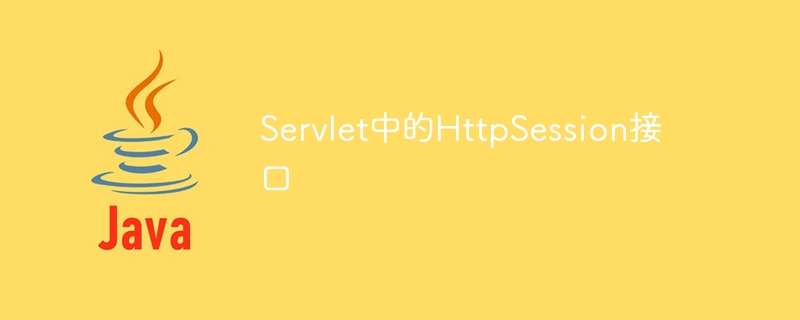HttpSession interface in Servlet
Sep 02, 2023 am 10:05 AM
In the world of Java web development, understanding the HttpSession interface is key to creating dynamic and responsive web applications. In this article, we will explore what the HttpSession interface is, how it works, and why it plays a crucial role in the Servlet specification.
What is the HttpSession interface?
The core of the HttpSession interface is a fundamental component of the Java Servlet API, which enables web developers to track a user's session across multiple HTTP requests.
When a user accesses a web application for the first time, a unique session is created to represent their interaction. This session allows the application to maintain state between requests and remember information about the user, which is critical for stateless protocols like HTTP. In Java, this functionality is implemented using the HttpSession interface.
Understanding the HttpSession interface: basic knowledge
Let us use an example to illustrate how HttpSession works -
HttpSession session = request.getSession(); // Create a new session or use an existing one
session.setAttribute("username", "JohnDoe"); // Store an attribute in the session
This simple code snippet creates a session and stores the username attribute in it.
Key methods of HttpSession interface
The HttpSession interface provides a set of useful methods to help effectively manage user sessions. Here are some key takeaways and short examples -
getAttribute(String name) - Returns the attribute value for the given attribute name.
String username = (String) session.getAttribute("username");
getAttributeNames() - Returns an enumeration of all attribute names associated with the session.
Enumeration<String> attributeNames = session.getAttributeNames();
while(attributeNames.hasMoreElements()){
String name = attributeNames.nextElement();
System.out.println(name);
}
getCreationTime() - Returns the creation time of the session.
long creationTime = session.getCreationTime();
getId() - Returns the unique identifier assigned to this session.
String sessionId = session.getId();
getLastAccessedTime() - Provides the last access time of the session
long lastAccessed = session.getLastAccessedTime();
setAttribute(String name, Object value) - Bind an object to this session
session.setAttribute("cart", shoppingCart);
removeAttribute(String name) - Removes the object associated with name from this session.
session.removeAttribute("username");
The meaning of HttpSession
Why is the HttpSession interface important? Here are three reasons -
State Maintenance - Despite the inherent statelessness of HTTP, HttpSession enables your web application to maintain user-specific state information.
Security Enhancements - HttpSession facilitates user authentication, allowing access to sensitive resources and web pages to be controlled based on the user's login status.
-
E-commerce support - HttpSession can track shopping cart items on various pages until the user checks out, which is very valuable for e-commerce platforms.
李>
HttpSession Best Practices
To ensure efficient and safe use of HttpSession, consider the following best practices -
Limit session data - Avoid storing too much data in the session to prevent performance bottlenecks. Keep session data minimal and concise.
Implementing session timeouts - Setting session timeouts can help reduce the risk of session staleness.
Secure Session Data - Ensure sensitive data is stored securely to prevent unauthorized access.
Handling Session Termination - Ensure sessions are properly terminated, especially when the user logs out, to maintain application security.
in conclusion
In summary, the HttpSession interface in the Servlet specification is a powerful and flexible tool for maintaining state and user data across HTTP requests. With proper understanding and appropriate use, it can significantly enhance the functionality and user experience of a web application.
The above is the detailed content of HttpSession interface in Servlet. For more information, please follow other related articles on the PHP Chinese website!

Hot Article

Hot tools Tags

Hot Article

Hot Article Tags

Notepad++7.3.1
Easy-to-use and free code editor

SublimeText3 Chinese version
Chinese version, very easy to use

Zend Studio 13.0.1
Powerful PHP integrated development environment

Dreamweaver CS6
Visual web development tools

SublimeText3 Mac version
God-level code editing software (SublimeText3)

Hot Topics
 What are the internal interfaces of a computer motherboard? Recommended introduction to the internal interfaces of a computer motherboard
Mar 12, 2024 pm 04:34 PM
What are the internal interfaces of a computer motherboard? Recommended introduction to the internal interfaces of a computer motherboard
Mar 12, 2024 pm 04:34 PM
What are the internal interfaces of a computer motherboard? Recommended introduction to the internal interfaces of a computer motherboard
 Common programming paradigms and design patterns in Go language
Mar 04, 2024 pm 06:06 PM
Common programming paradigms and design patterns in Go language
Mar 04, 2024 pm 06:06 PM
Common programming paradigms and design patterns in Go language
 What are the application scenarios of Java Servlet?
Apr 17, 2024 am 08:21 AM
What are the application scenarios of Java Servlet?
Apr 17, 2024 am 08:21 AM
What are the application scenarios of Java Servlet?
 Introduction to PHP interfaces and how to define them
Mar 23, 2024 am 09:00 AM
Introduction to PHP interfaces and how to define them
Mar 23, 2024 am 09:00 AM
Introduction to PHP interfaces and how to define them
 How does Java Servlet implement distributed session management?
Apr 16, 2024 pm 02:48 PM
How does Java Servlet implement distributed session management?
Apr 16, 2024 pm 02:48 PM
How does Java Servlet implement distributed session management?
 Insight into Hongmeng system: actual function measurement and usage experience
Mar 23, 2024 am 10:45 AM
Insight into Hongmeng system: actual function measurement and usage experience
Mar 23, 2024 am 10:45 AM
Insight into Hongmeng system: actual function measurement and usage experience
 Inner class implementation of interfaces and abstract classes in Java
Apr 30, 2024 pm 02:03 PM
Inner class implementation of interfaces and abstract classes in Java
Apr 30, 2024 pm 02:03 PM
Inner class implementation of interfaces and abstract classes in Java








